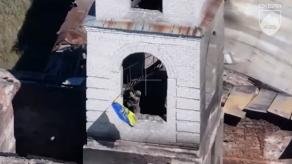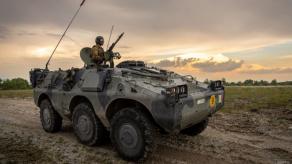Late March 2024, russian Minister of Defense Sergei Shoigu announced that the so-called "Dnieper River Flotilla" with a brigade of river boats had already been formed. But then state-controlled media backed out saying that the "Dnieper flotilla" is rather still in the early stages of creation, and they are yet to get equipment and weapons for the unit.
Finding the assets, however, may come as problematic because earlier, in a report by russian TASS, the ex-Chief of the General Staff of the russian Navy (1998-2005) Viktor Kravchenko essentially said that the equipment for the newly established "Dnieper flotilla," will be plundered from their Caspian Flotilla. Now the Kremlin's media reveal that among the weapons allocated, there will be the unique A-222 Bereg 130mm coastal guns from the Black Sea Fleet transferred to the new riverine unit.
Read more: RBU-6000 Rocket Launcher on MT-LB Chassis is a Weird Weapon But it Works and it Shoots

Until now, the A-222 Bereg self-propelled naval artillery system has never been mentioned in the context of russia's war against Ukraine, so we should take a closer look at these mobile cannon systems and their capabilities.
To begin with, there are only 36 units of A-222 Bereg system available, some sources claim that all of them are gathered within the Black Sea Fleet of the russian Navy. The system uses a derivative of the AK-130 naval cannon (also used on Project 1164 guided-missile cruisers, including the destroyed Moskva). The baseline weapon's specs are:
- caliber: 130 millimeters,
- barrel length: 54 calibers,
- firing range up to 23 kilometers,
- rate of fire: up to 10–12 shots per minute,
- ammunition capacity for 40 shots.

The A-222 Bereg self-propelled system was designed in the Soviet Union to cover the dead zones which could not be covered by coastal defense missile systems. The quazi-howitzer was tested in 1988 but adopted only in 1996, and the first mass-produced unit was delivered in 2003.
Probably, the small volumes of production and deliveries are due to the fact russia was struggling to find foreign buyers for this quite peculiar weapon system, despite actively seeking opportunities for export.
As for the practical benefits that the A-222 Bereg can offer the russian invasion forces fighting in Ukraine, we should pay attention to the following aspects. First of all, there are no indications of the presence of at least a minimum level of protection on this moving 130mm naval gun.

The standard firing tactic for A-222 Bereg is in a battery of two guns (some sources suggest up to 6 units), the fire control is provided by the battery command post vehicle equipped with a radar and an electro-optical station similar in operating principle to LIDAR. That is, Bereg is a de facto unprotected self-propelled gun with poor survivability on the battlefield. The drawback could be mitigated, though, by abandoning the idea to deploy a whole battery to the firing spot but in that case, the accuracy of fire will plummet.
But apparently, the russians themselves consider those shortcomings too insignificant to deny themselves the advantage offered by the weapon's firepower. Moreover, they claim that this coastal defense system can destroy land-based targets as well, and that the A-222 Bereg can use two main types of ordnance: the F-44 high-explosive fragmentation projectile and the ZS-44 anti-aircraft round.
Read more: Ukrainian Navy Showcases Rare Weapons: Gun Truck with a 2M-3M Anti-Aircraft Gun and the Island Boat (Photo)














